Horta (Χόρτα)
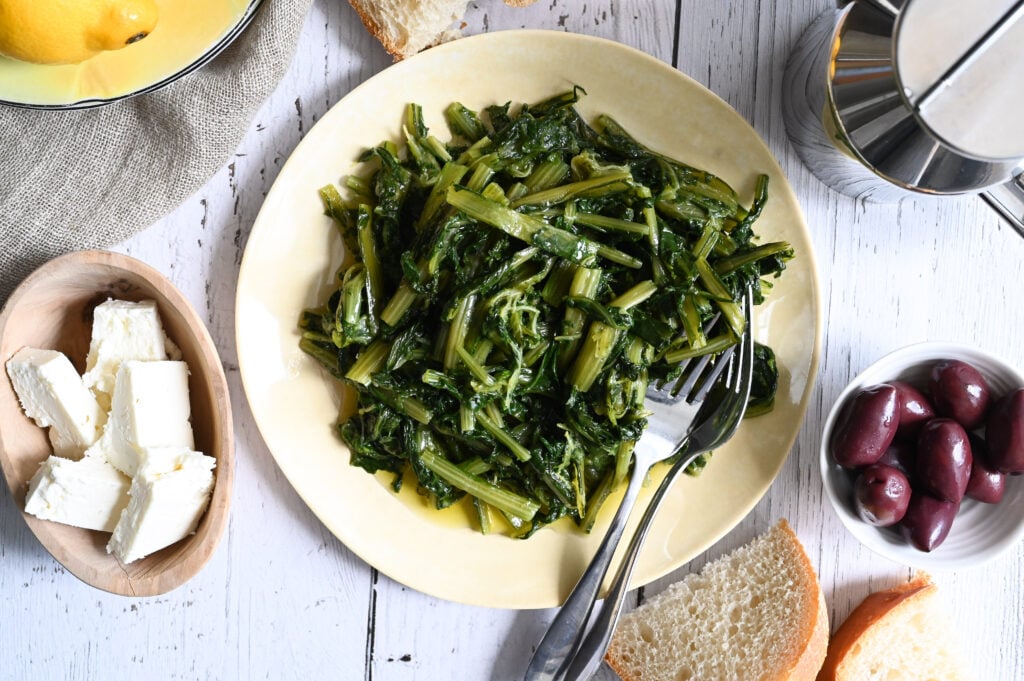
Dandelion leaves are a Greek recipe staple. Delicious, nutritious, and depending on how you get them…free!
There are some things which are simply, quintessentially, Greek. Your mother insisting that you not leave the house with wet hair, to avoid pneumonia, is one. Having several members of your family with the same first name, sometimes paired with the same last name, is another. Calling anyone who is even remotely related to you, your cousin, is yet another. And horta-picking…well, that is one, perfect, Greek thing.
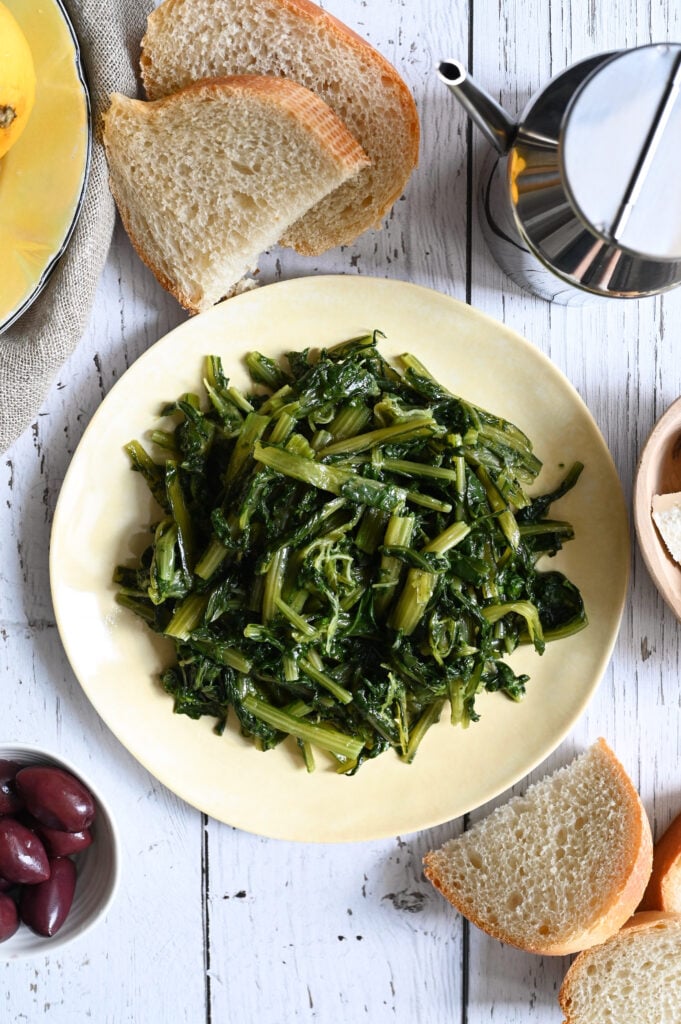
For most non-Greek families, a drive is just that; a way to get from one place to another. Not for our family. Growing up, if it was the right time of year (early May to the end of June), a drive out to see Costa Pappas (no, not that Costa Pappas…the other one), often meant a little pit stop by the side of the road to gather lunch. Yes, that’s right. While our father drove, our mother, who must have an embedded horta-radar, would gaze out the window, not to take in the scenery, but to see if she could spot some wild dandelion greens, ready to be picked. She often did. And when she did, the car was stopped, and out of the trunk came the always available horta-picking tools; sharp pairing knives and plastic garbage bags. High class. Her radar must have a far-reaching range because we would then trek out into the middle of nowhere to start the picking. Of course, these spontaneous trips to the field were complemented by the many occasions when horta-picking was a planned activity. As a result, a possible exchange with a friend from school would have gone something like this:
Either of us: Hi Jane. I love how your long, blond, hair looks today.
Jane: Thanks. It’s nothing. I just left the house right after taking a shower and the wind dried my hair, giving it this wavy look.
Either of us: Really???!!! What are you doing this weekend? (fully expecting that she would be hospitalized)
Jane: Probably going to the theater with my parents, and then going out for sushi or something. What about you?
Either of us: Oh. We’re going to be picking weeds, so that we can eat them. We will be doing this with our parents, aunts, uncles and about 10 cousins.
Truth is, we were horrified by this practice growing up. Often, holding open the garbage bags so that our parents could toss in weeds, we would look around furtively, fearing that someone we knew would spot us. But who would spot us? Horta-picking happened in remote places, far from automobile exhaust, dog poop and pesticides or fertilizers. This was organic harvesting at its best. When the fields were particularly abundant, our parents told us to lay the bags on the ground, and handed us knives. We were taught to find a nice weed, insert the knife into the ground, and cut in a circular movement; this would cut the dandelion greens, but leave the root intact; perfect for future growing (not that weeds actually need the help). It was pretty easy work and there were times when, in spite of ourselves, we took pride in finding the perfect weed.
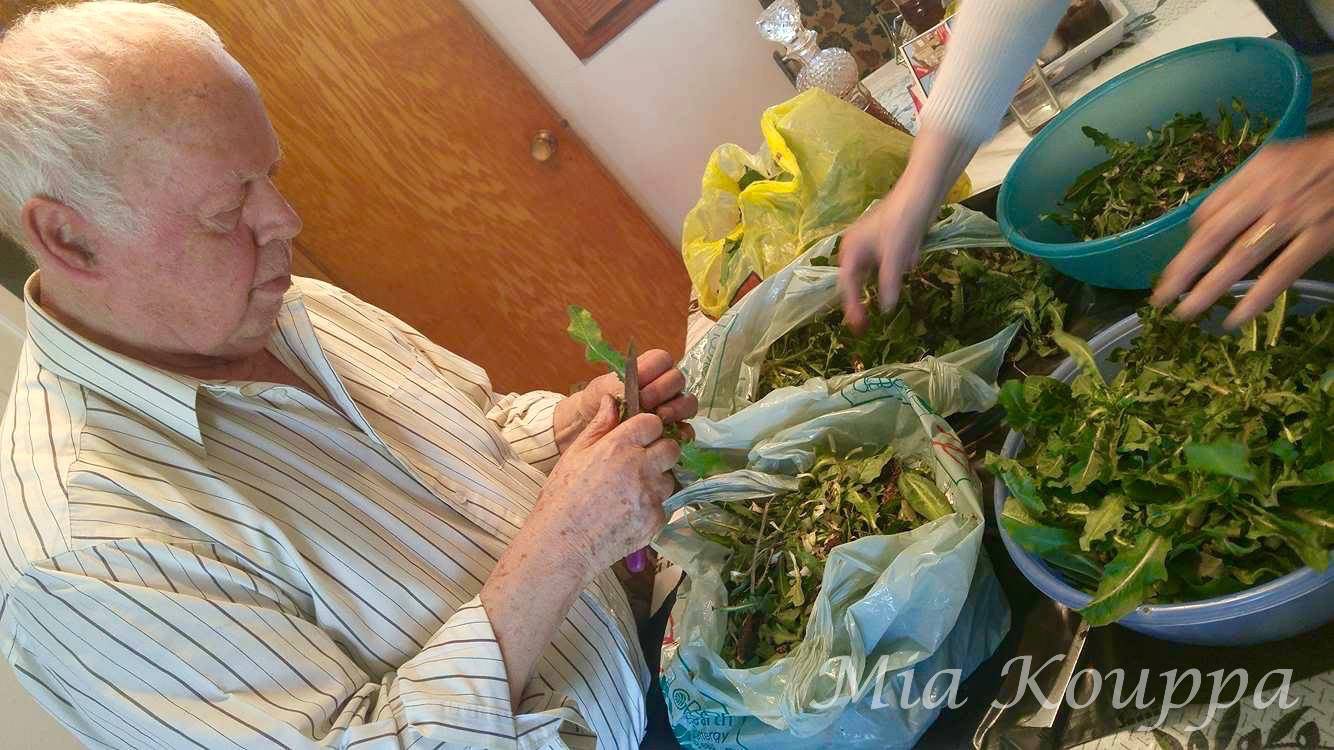
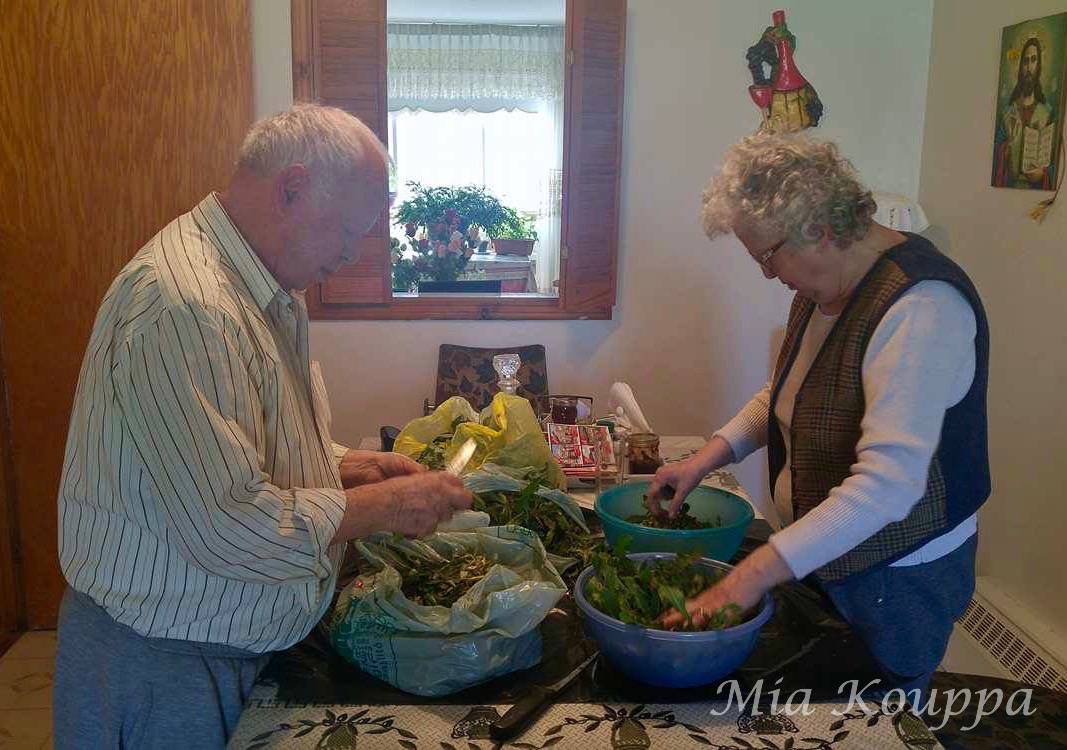
Despite the fear of being seen, the picking part was easy. The cleaning and washing of the accumulated horta however, was another story. Depending on the quantity of our bounty, this process could take the better part of an afternoon. We would sit on the balcony with our parents, and often other family members, sorting through the horta. We would carefully cut away any pieces which were brown or wilted. Any accidental roots were also discarded. The remaining greens were then washed, and then washed again, and again, and again. The washing continued until the water in which the greens were washed was finally, ultimately, clean.
Today, our parents still plan their horta-picking excursions, and today, we actually welcome an invitation to join them. As we have gotten older, our fragile egos have been replaced by pride, embracing horta-picking as an integral part of our culture. We acknowledge that there is beauty in knowing how to live off the land, so to speak. We also know that horta are delicious, and so very nutritious. Loaded with vitamins A, K and C, high in fiber, and very low in calories, they are a peppery delight which you should definitely try to incorporate into your diet.
Helpful hints:
Horta translates into weeds, and in Greek, if you are vegetarian you are called a hortofaga, which literally means weed-eater. Isn’t that a funny word? The term horta is often used to describe any wild greens, and could include wild spinach, nettles, beetroot leaves and many other things. Here, as in our parents’ home, horta refers to wild dandelion greens.
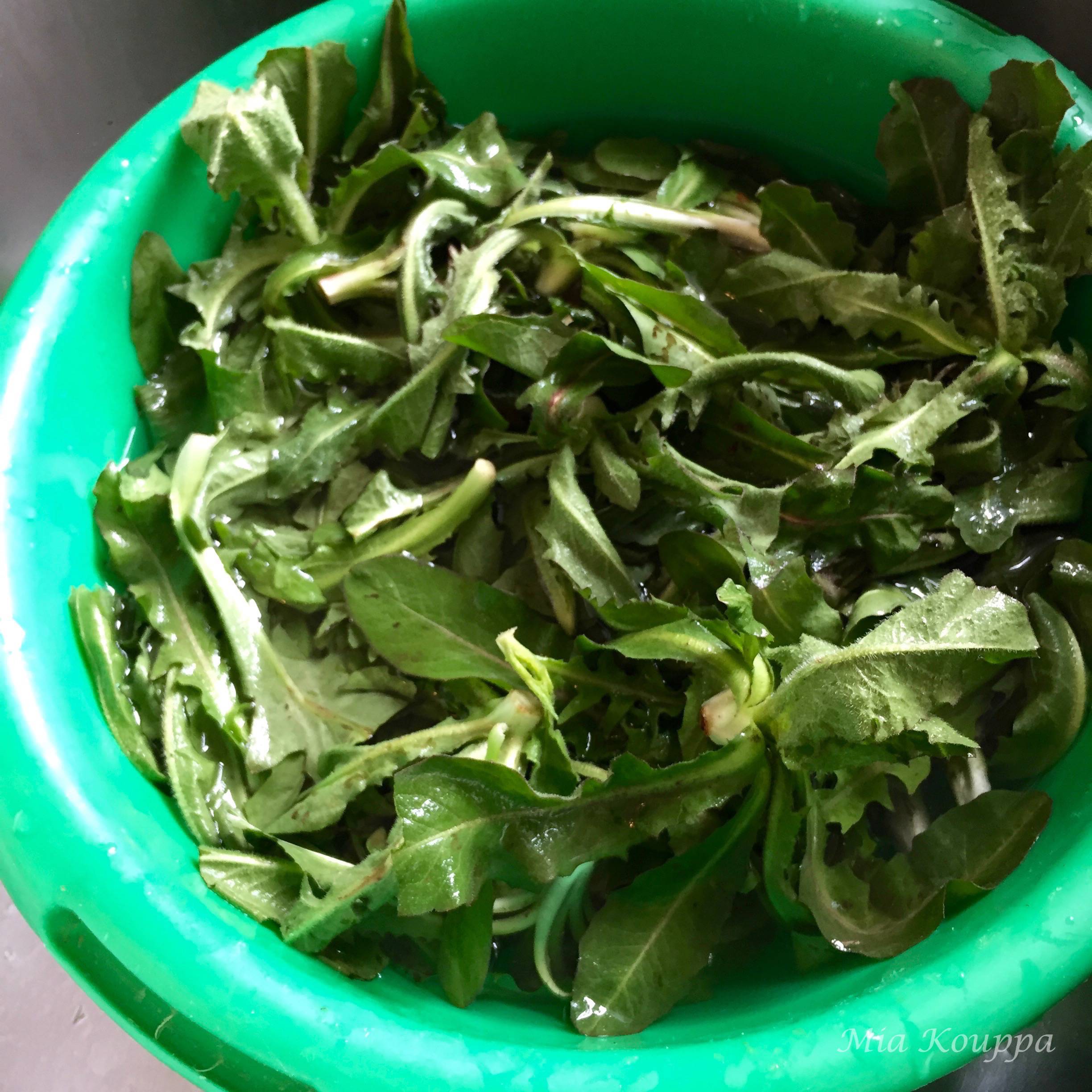
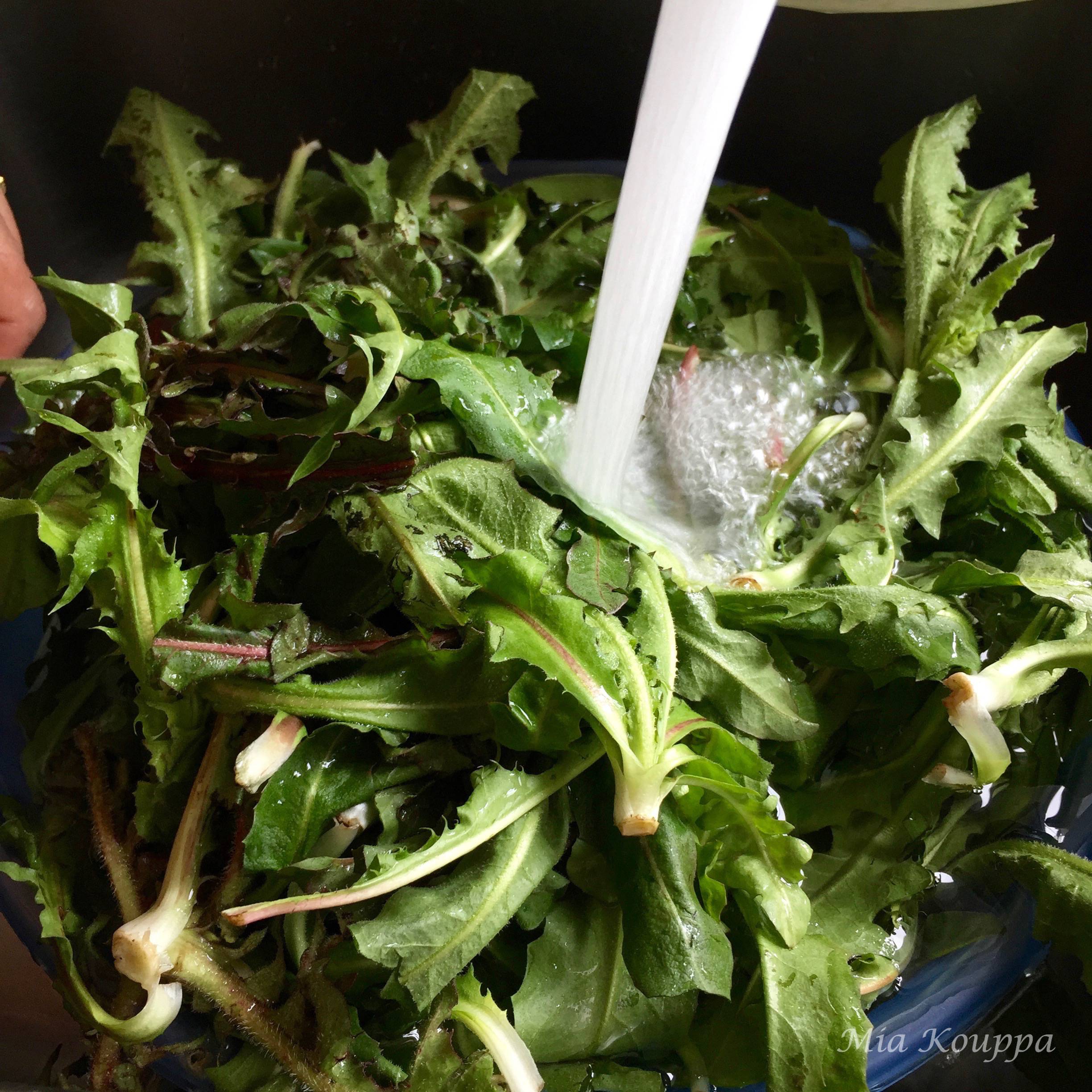
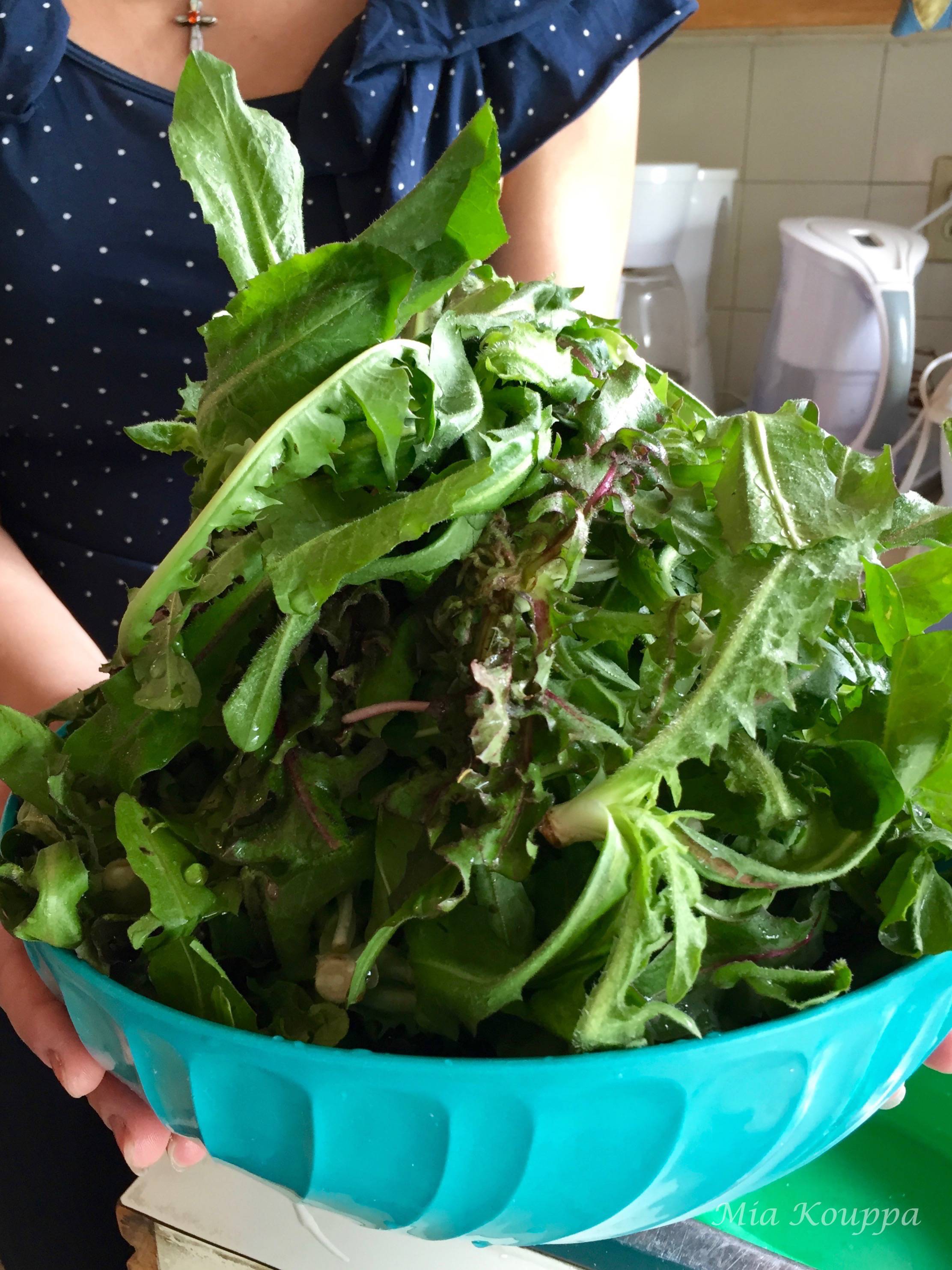
We realize that horta-picking isn’t for everyone. Perhaps you have never been taught how to pick the right weed, or don’t know where to go. Or maybe you would rather purchase your food in a grocery store. We don’t judge. Lucky for you, dandelion greens are often readily available in the produce section of many grocery stores. We don’t think that they taste nearly as good as those you might pick in an open field, but they are still delicious (and good for you).
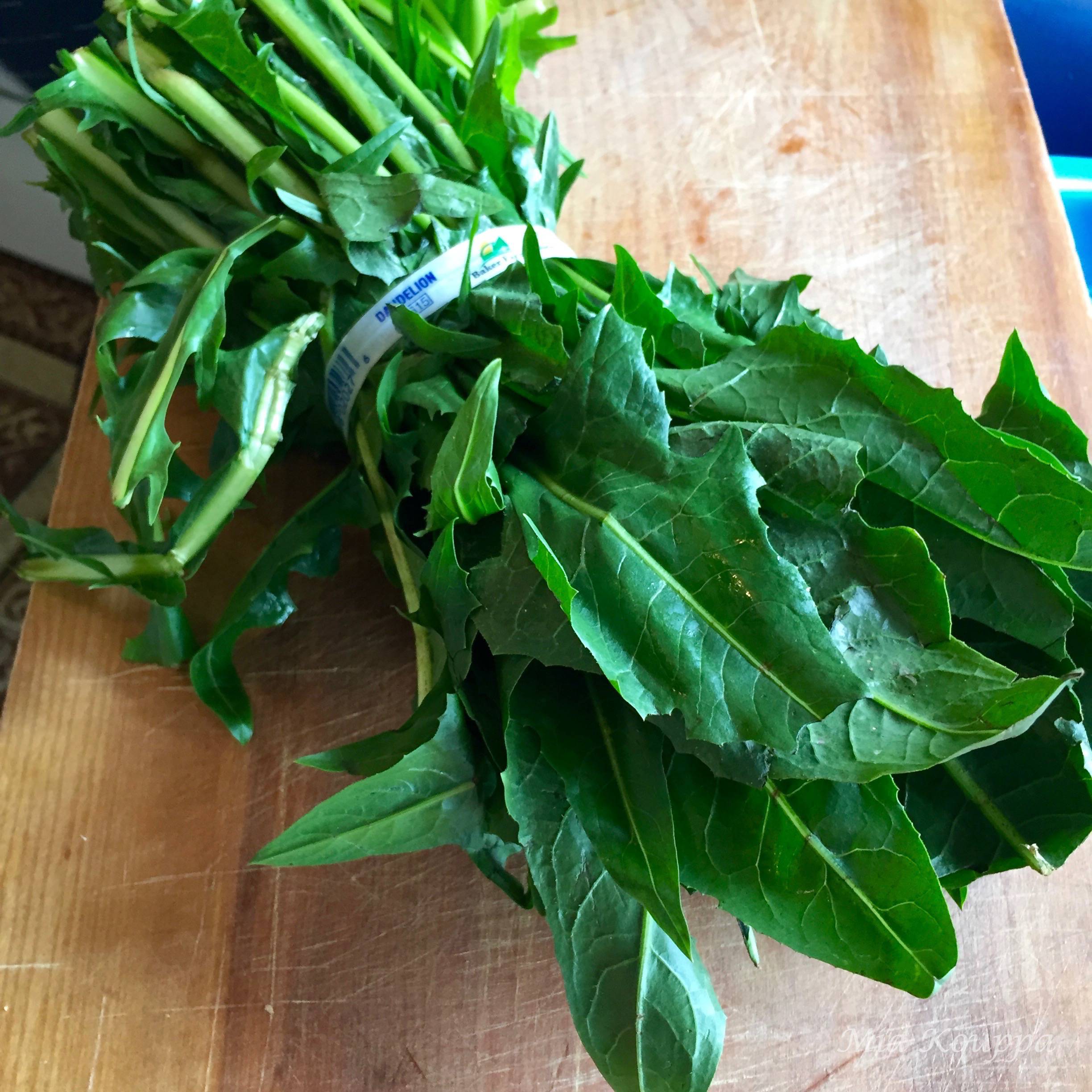
Along with being more delicious, the horta you pick yourself will also be significantly dirtier than those at your local food market. Therefore, cleaning them can be quite an onerous task. If possible, especially if you have bags and bags full, clean your horta outdoors, and use a garden hose to fill and refill the bowls you will be using to clean the dirt and grit off of them (see description of how to do this in the recipe). The nice thing about doing this outside is that you can simply pour the dirty water into the garden or grass, or any potted plants. If you cannot clean your horta immediately after picking them, store them in the refrigerator for a few days.
Keeping horta fresh is key, especially if you have spent all day picking and preparing them. If you have more horta than you can possible eat, prepare them as described below and then store individual or family serving sizes in freezer bags, and freeze them. When you are ready for a taste, simply defrost a bag and immerse the horta quickly in a pot of boiling water, just to heat them through. They will be as fresh as the day you picked them!
As with most greens, when you cook your horta, the quantity you started off with will dramatically reduce in volume. Estimate that you will need about 1.5 pounds (680 grams) for 4 servings. This, of course, will depend upon whether you eat your horta as a meal or a side dish.
The time that it takes for your horta to cook will be largely dependant upon the freshness and size of your horta. Use the suggested cooking time in the recipe below as an estimate.
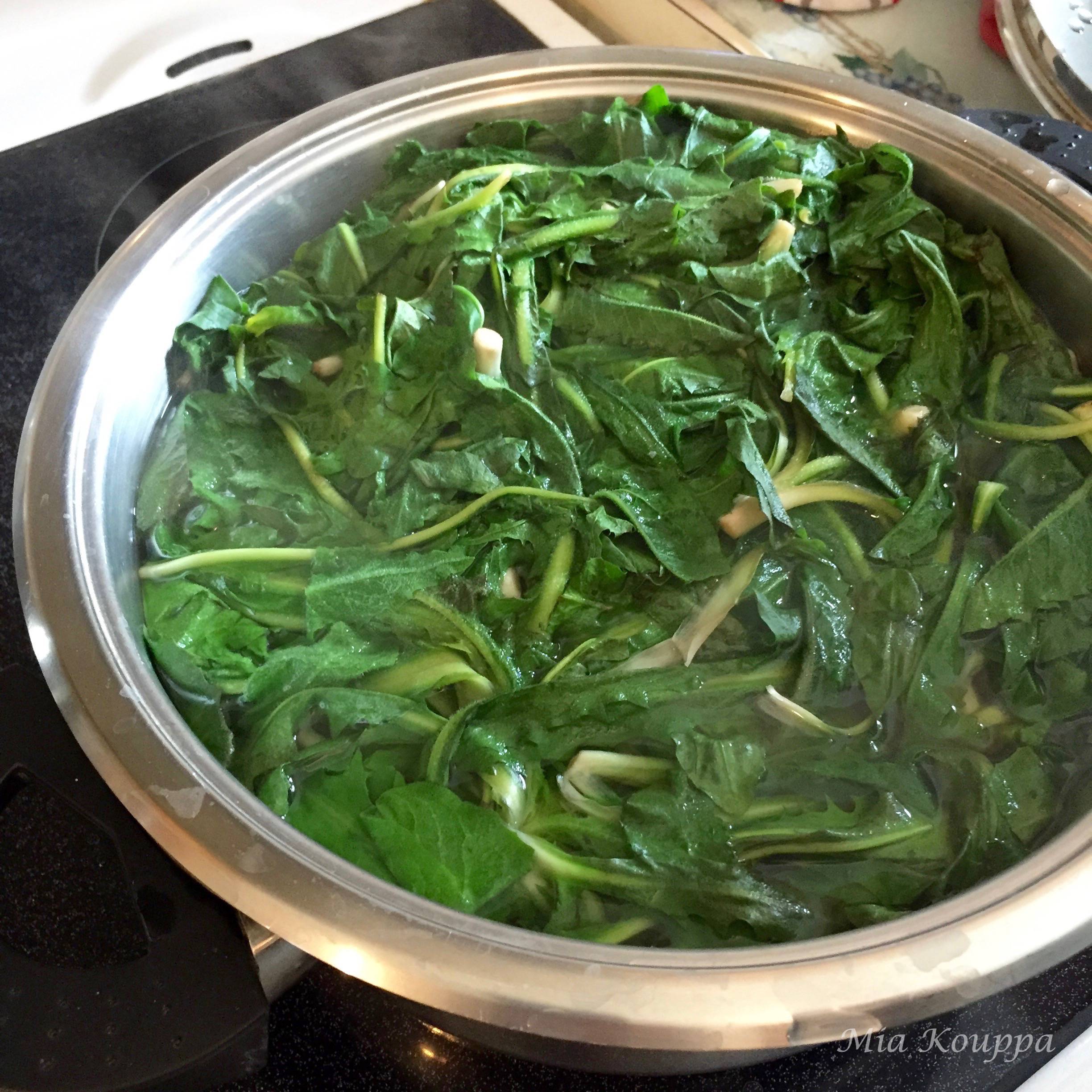
If you are using organic horta (either those you have picked yourself, or those you may have purchased), consider reserving the water that they were boiled in and drinking it as a tea. In the spirit of waste nothing, our parents reserve the cooking liquid to either drink as is, or they add some of it to soups or broths. As a drink, it is a bit bitter and therefore somewhat of an acquired taste, but it is apparently very good for you, so definitely worth a try. You can always try sweetening it with a bit of honey or sugar.

The best way to eat horta is with some lemon (or lime) juice and a drizzling of Greek olive oil. We feel they are most delicious at room temperature.
Looking for some more greens to enjoy? Try these:
Broccoli with olive oil and lemon
Dandelion greens and grilled bread

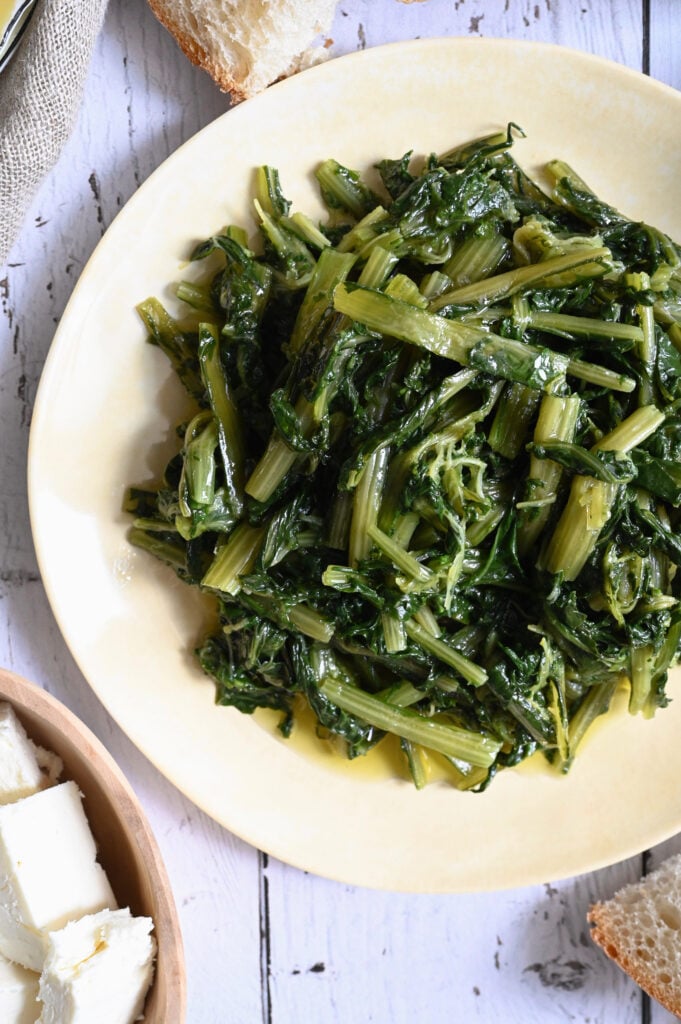
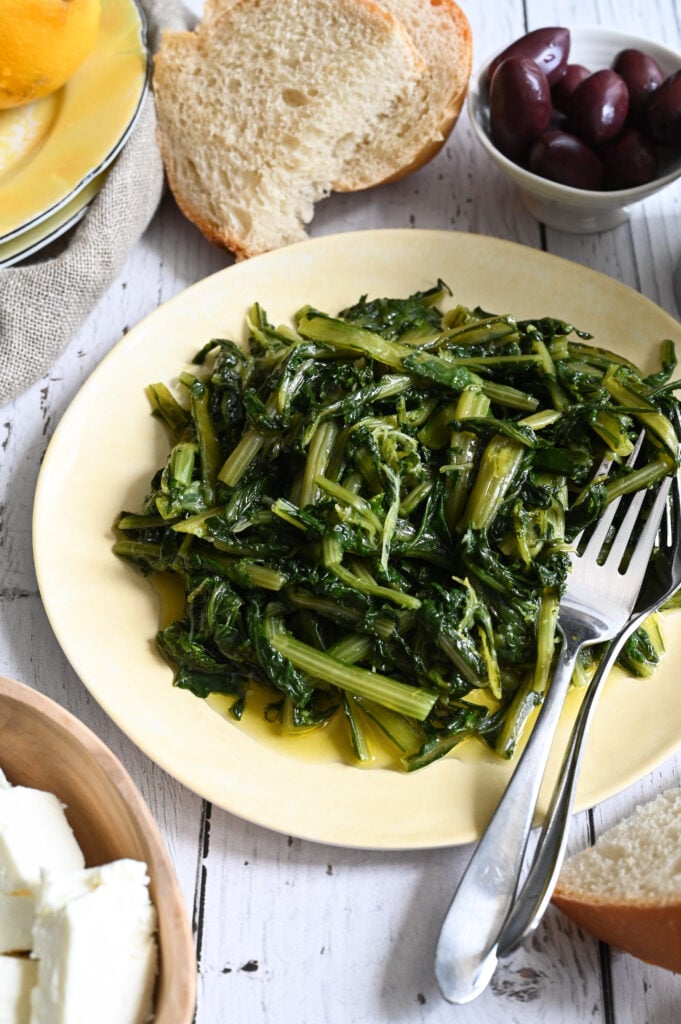
We love hearing from you! If you have made our recipes, or if you have a question or comment, or simply want to say Hi!, please leave a comment and star rating below! Also be sure to follow along with us, on Facebook, Instagram and Pinterest. We have lots of fun over there.
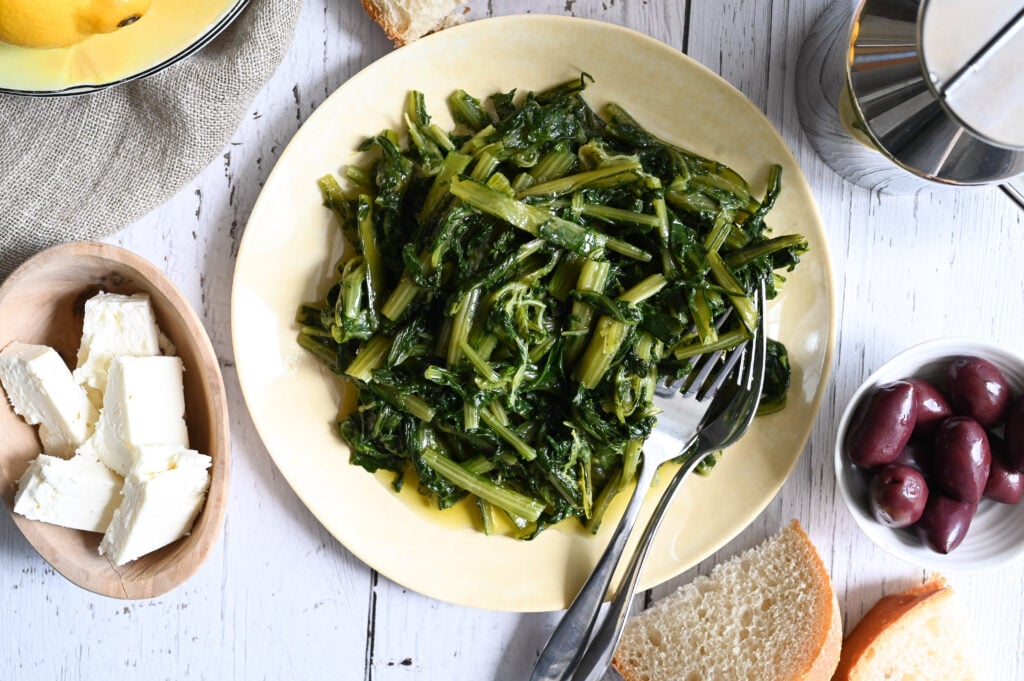
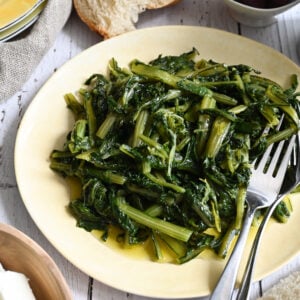
Horta (Dandelion leaves)
Equipment
- 2 large bowls to rinse the horta
- 1 large sauce pot
Ingredients
- Horta (wild dandelion greens) See notes below.
- Salt, to taste
- Lemon or lime juice, to taste
- Olive oil, to taste
Instructions
- Pick through your horta and remove any leaves which are brown or discoloured.
- Remove any roots, and excess dirt. Next, carefully wash your horta. The best way to do this is to work with two large bowls. Fill each one with water and immerse your horta, a few handfuls at a time, into the first bowl. Place your hand into the water with the horta and shake it around, almost like the agitator of a washing machine would . After you do this for about 30 seconds, move the horta over to the next bowl which is also filled with water. Empty the first bowl, and refill with water. Repeat the agitator motion in the second bowl.
- Repeat until the water left behind when you transfer your horta, is crystal clear.
- Bring a large pot of water to a boil. Add salt to taste to the water (usually we add 1 teaspoon per 4 liters of water). Once the water has come to a boil, add your horta.
- Cook, uncovered, over medium heat for approximately 20 – 25 minutes, until the horta are tender. Every 5 minutes or so, stir the horta around in the pot.
- Drain, but reserve the cooking liquid.
- Right before you are planning to serve your horta, gently drizzle with lemon juice and olive oil. You can add salt at this point as well, if you desire.
- Store the reserved liquid in the refrigerator until you are ready to drink it or use it. If you plan on drinking it as a tea, you can add a bit of honey to cut the bitterness.
- Enjoy!

Dandelions that grow in my back yard? They begin as puff balls and turn into yellow flowers? So interesting.
Yes! Isn’t it incredible? We only eat the green leaves which surround the yellow flowers… although I think the flowers are edible too! We used to have a tortoise, and those were her favourite treat 🙂
You took me back to the Chicago Forest preserve where my brothers and I were spotted by classmates while we were digging our knives in that circular motion as you describe! This is the most comprehensive explanation of χόρτα I have ever seen. You capture the evolution of our feelings & attitude towards horta from odd child days to the Mediterranean diet seeking ones as we realize we were born into a culture others admire. Great recipe as well as story. Bravo! Will explore your other recipes. Thanks.
Thank you so much for this kind comment Georgia. We love to hear how our stories help others remember their own. I hope that you enjoy the rest of our recipes. 🙂
I grew up in Chicago, too, and we also picked our grape leaves from the wild grape Vines in the forest preserves. We would pick vleeta from corn fields in the area unless the farmer chased us away.
These are some of the most amazing memories aren’t they?! 🙂 xoxo Helen & Billie
I remember my late father eating them and exclaiming that it was the best food in the world. He ate crusty bread and feta with his or sometimes tuna fish as well. He would soak up the olive oil and juices with the bread. And an orange juice glass of “crassie” (sp) wine.
Sometimes I wonder if horta is not why the Greek diet is so full of nutrition.
Thank you Gigi for sharing this about your father. We tend to agree, that horta are some of the best things to eat :), especially when paired with some homemade “crassie” 🙂
I love the way you write .. 😊You explain the feeling of being proud and thankful for our culture that only comes with age. I laughed at this story as I saw myself as a child following my mum around a paddock with a plastic bag , not wanting to be there .
Thank you so much Vasilia. That truly means a lot. I’m so happy that this story make you chuckle, and had you remember happy (at least now!) childhood memories 🙂
So well put! I agree 100%!
Thank you so much xoxo Helen & Billie
I remember Horta very well! My Yiayia and Papou grew it in their garden in Miami. We would clean them up and cook them. Then drizzle wine vinegar and olive oil on top. So amazing! 🇬🇷
🙂 Hope that the post brought back fond memories! Aren’t they delicious?! That’s exactly how we love them too…with red wine vinegar, olive oil, and just a sprinkling of salt 🙂
Greek foods are the best!
Loved reading this, brought me back to my childhood, we always say that a good Greek woman always travels with a knife and plastic bag! My mother once jumped a fence to get to a field of xorta …..it was prison property and she had to try and explain to the guards that came why she was in the middle of a field with a knife ! LOL
Oh we’re so happy to hear that Marina! And the story of your mother breaking IN to prison….gold!!! Too funny!!! Thanks for sharing 🙂
Hi, ladies.
We picked up a packet of purslane seeds at the garden centre today. We have some Greek recipes for using it in salads. I’m also looking forward to using it in a horta pie with phyllo, or perhaps Epirote-fashion with cornmeal top and bottom crusts. Are there any pitfalls to avoid?
Hi Charles! Lucky to be gardening these days (it’s winter where we are!). We don’t really have any pitfalls to avoid necessarily – you seem to have a plan and it sounds delicious! Let us know what delicious things you make with your garden bounty 🙂 xoxo Helen & Billie
Dandelion leaves and root ( which is used for tea) has been proven to kill cancer cells. University of Windsor Biology department studied and patented the component that kills cancer in the dandelion. It only works with some kinds of cancer. I believe that it was leukemia that was cured with dandelion tea and eating the leaves.
There is so much about natural remedies that we don’t know. Dandelions leaves and the root are certainly healthy, and their full potential probably remains to be discovered! xoxo Helen & Billie
I used to hate coming back home with garbage bags full of Xorta (for my friends and neighbours to see) that my mother used to force me to go with her. I can’t even imagine what my own kids would say if I did this lol. I buy my xorta at the grocery store and I do drink the water they were boiled in. I love it. I add some lemon and salt to it.
We feel your pain Maria! We grew up in a neighbourhood with lots of other Greek families, so many of our friends understood our struggles – they were often out there in the fields with us! But for our non-Greek friends, this was just something too crazy to comprehend! lol. Enjoy your horta, no matter where you get them 🙂 xoxo Helen & Billie
We still have the wood handled knife my parents used to forage Horta on remote roadsides and fields. My brother and I, mortified, would sink in the backseat so nobody would see us. They’d get back in the car with bags of greens, and that muddy knife would go back in the glovebox for the next trip. It was almost as bad as when they’d play the old Greek 8-tracks in the car with the windows down.
Ha ha! We can so relate! It is a wonder we survived our childhoods! 🙂 xoxo Helen & Billie